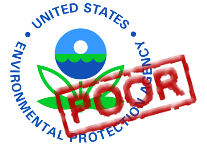With farmers facing corn rootworm resistance in at least 13 states, the Environmental Protection Agency has proposed a framework earlier in the year to improve the corn rootworm resistance management program.
|
|
|||
|
The Economic Research Service, an arm of the U.S. Department of Agriculture, in its second report, Genetically Engineered Crops in the United States, downplayed the impact of glyphosate resistance and gave Bt crops the kid gloves treatment. The European Commission recently said it will ban three neonicotinoids for the next two years citing “acute high risks” to bees associated with this pesticide. The EPA only recommends more tests. Cholesterol decreasing juice, anti-cancer green tea, and cherries as James-Bond agents to neutralize cancer — believable or not? FDA’s confusing food labeling rules are criticized for allowing many companies to make misleading claims on food labels. Public Employees For Environmental Responsibility sued for the release of FDA’s records that would demonstrate the effectiveness of the agency’s voluntary approach of phasing out the use of medically important antibiotics on animal farms. Guess what they revealed. Sorry, recently said the FDA to the Corn Refiners Association but “high fructose corn syrup” is just not “corn sugar.” The industry group persists, however, citing of all things the main argument for GMO labeling. The FDA took long-overdue steps towards curbing the overuse of antibiotics in farm animals aimed to preserve effectiveness of antibiotics. Unfortunately, the measures remain voluntary and industry compliance remains to be seen. Internal investigators found significant weaknesses in FDA’s monitoring of State agencies’ food inspections. The finding raises further questions about FDA’s effectiveness in ensuring the safety of the nation’s food supply. The U.S. House Committee on Agriculture is meeting to “review the causes and consequences of government over-regulation of agriculture biotechnology.” If approved by the FDA, a new bill introduced in California, known as The Consumers Right To Know Act, would require labeling on all genetically engineered salmon sold in California. A bill that waters down EPA protections of the Clean Water Act is recommended for consideration by the House as a whole. This is one of several Republican sponsored bills aimed at reducing EPA powers. The usual and unusual politics surrounding the deregulation of genetically engineered alfalfa. In less than a month, USDA has approved for unrestricted growth GE alfalfa and partially deregulated GE sugar beets. Now, it deregulates GE corn for biofuel production with no environmental impact study of novel proteins it contains. Yesterday, USDA’s Sec. Tom Vilsack announced that genetically engineered alfalfa, that has been modified to withstand repeated application of Monsanto’s RoundUp herbicide, will be completely deregulated nation-wide, without any restrictions. The Food and Drug Administration has preliminarily determined that a genetically modified salmon developed by AquaBounty Technologies is safe for human consumption but many questions about the safety of GE salmon persist. A coalition of agriculture groups and 75 Members of Congress wrote to Tom Vilsack, urging the USDA to allow limited planting of Roundup Ready alfalfa while the agency completes an Environmental Impact Statement. Ever since the Supreme Court handed down its mixed 7-1 decision, ruling that the lower court overstepped its boundary by issuing an injunction on the planting of genetically modified alfalfa, some lawmakers were spurred to action. In December 2009, the USDA has released its draft environmental impact statement proposing to deregulate Monsanto’s genetically engineered alfalfa. GMO Journal submitted its public comment to the agency urging it to continue regulating GE alfalfa. There is still time to take action before the March 3, 2010 deadline. Do you part — tell USDA to reject Monsanto’s GE alfalfa. The United States Department of Agriculture (“USDA”) and its Animal and Plant Health Inspection Service (“APHIS), which oversees biotechnology regulation, was heavily criticized by its own Inspector General 2005 audit report. Did APHIS change its way since then? As a result of policies enumerated by the Coordinated Framework, regulatory control over GMOs in the United States was divided among different regulatory agencies. The consequences of such a decision was a myopic, and at times, haphazard regulatory control by each agency over GMOs. For USDA, this raises significant questions as to the agency’s ability to effectively regulate second generation GMOs. How can the public trust government agencies to ensure the safety of GMOs if those agencies have a long track record of failure? USDA’s regulatory track record begs the question of whether it is a government “regulatory” agency or an industry group. Industry bias, lax scientific standards, exemption of food crops containing pesticides from registration requirements, and failure to independently monitor GM crops after approval, are among the regulatory problems exhibited by the EPA when it comes to regulating GMOs. The USDA provides a number of exemptions for articles that it has determined do not pose a plant pest risk. One of such exemptions authorizes the introduction of certain regulated articles without a permit provided that USDA is notified in advance. |
|||
|
 |
|||
















